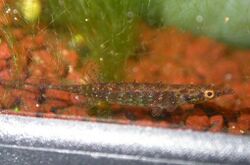Biology:Indostomus
| Indostomus | |
|---|---|

| |
| I. paradoxus in an aquarium | |
| Scientific classification | |
| Kingdom: | |
| Phylum: | |
| Class: | |
| Order: | |
| Family: | Indostomidae Prashad & Mukerji, 1929
|
| Genus: | Indostomus Prashad & Mukerji, 1929
|
Indostomus is a genus of small fishes native to slow moving or stagnant freshwater habitats in Indochina.[1] It is the sole genus of the monogeneric family Indostomidae, Long considered to be sticklebacks, within the order Gasterosteiformes, modern analyses place the Indostomids within the order Synbranchiformes, related to the spiny eels and swamp eels.[2][3]
Description
Indostomus species are all incredibly small, on average reaching 3 cm in length at maximum. Their bodies are armored and thin, tapering towards the back, and ending in a small, fan-shaped tail. They are sexually dimorphic, with mature females outwardly showing the presence of eggs with a broader, fuller abdomen, and, in the case of Indostomus crocodilus, mature males have white bands along the edges of the dorsal, anal, and ventral fins.
Habitat
Indostomus species show a clear preference for slow moving and stagnant freshwater wetlands, streams, ponds, and oxbow lakes, including both clearwater and blackwater habitats. Indostomus are often found around aquatic plant growth, algae, and decaying organic material such as leaf litter and branches. Sympatric fishes include danionins, Dario, and gouramis.
Behavior and Diet
Indostomus are micropredatory fish, predating on small aquatic insects, crustaceans, and worms. In an aquarium setting, Indostomus will often refuse prepared foods, only eating very small live or frozen foods such as copepods, Artemia, Daphnia, or Moina.
Indostomus will spawn in very small caves and crevices, such as in reeds, bamboo, or very small lengths of plastic piping. Individual males will select a spawning site, and guard the eggs and nest until the fry are free swimming and disperse.[4]
Species
The three currently recognized species in this genus are:[5]
- Indostomus crocodilus Britz & Kottelat, 1999
- Indostomus paradoxus Prashad & Mukerji, 1929 (armoured stickleback, pipe fish)
- Indostomus spinosus Britz & Kottelat, 1999
Indostomus paradoxus, was discovered in the 1920s in Lake Indawgyi in Myanmar. In the 1990s, two other species were discovered and placed into the genus Indostomus.[6] Indostomus crocodilus from Thailand, and Indostomus spinosus from Mekong River basin. In 2001, I. tiliosi was listed as a possible new species, but has not yet been officially described.
References
- ↑ Froese, Rainer, and Daniel Pauly, eds. (2012). "Indostomidae" in FishBase. October 2012 version.
- ↑ Kawahara, Ryouka; Miya, Masaki; Mabuchi, Kohji; Lavoué, Sébastien; Inoue, Jun G.; Satoh, Takashi P.; Kawaguchi, Akira; Nishida, Mutsumi (2008). "Interrelationships of the 11 gasterosteiform families (sticklebacks, pipefishes, and their relatives): A new perspective based on whole mitogenome sequences from 75 higher teleosts". Molecular Phylogenetics and Evolution 46 (1): 224–236. doi:10.1016/j.ympev.2007.07.009. ISSN 10557903. PMID 17709262.
- ↑ Betancur-R, Ricardo; Wiley, Edward O.; Arratia, Gloria; Acero, Arturo; Bailly, Nicolas; Miya, Masaki; Lecointre, Guillaume; Ortí, Guillermo (2017-07-06). "Phylogenetic classification of bony fishes". BMC Evolutionary Biology 17 (1): 162. doi:10.1186/s12862-017-0958-3. ISSN 1471-2148. PMID 28683774. PMC 5501477. https://doi.org/10.1186/s12862-017-0958-3.
- ↑ "Indostomus crocodilus — Seriously Fish". https://www.seriouslyfish.com/species/indostomus-crocodilus/.
- ↑ Froese, Rainer and Pauly, Daniel, eds. (2012). Species of Indostomus in FishBase. October 2012 version.
- ↑ Britz, R. and M. Kottelat. (1999). Two new species of gasterosteiform fishes of the genus Indostomus (Teleostei: Indostomidae). Ichthyol. Explor. Freshwat. 10(4):327-336.
Further reading
- Berra, Tim M. (2001). Freshwater Fish Distribution. San Diego: Academic Press. ISBN:0-12-093156-7
Wikidata ☰ Q1968210 entry


